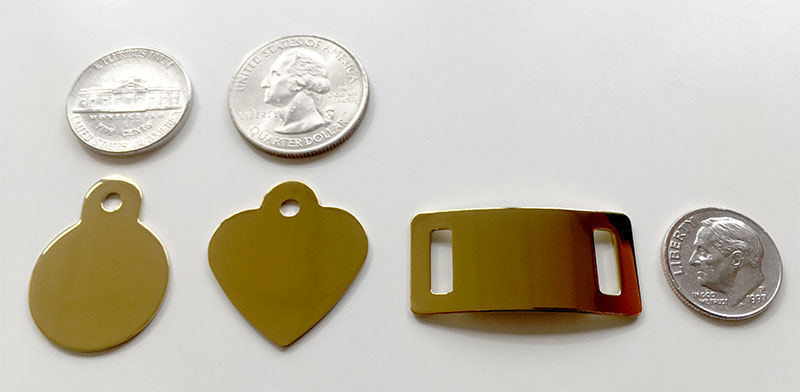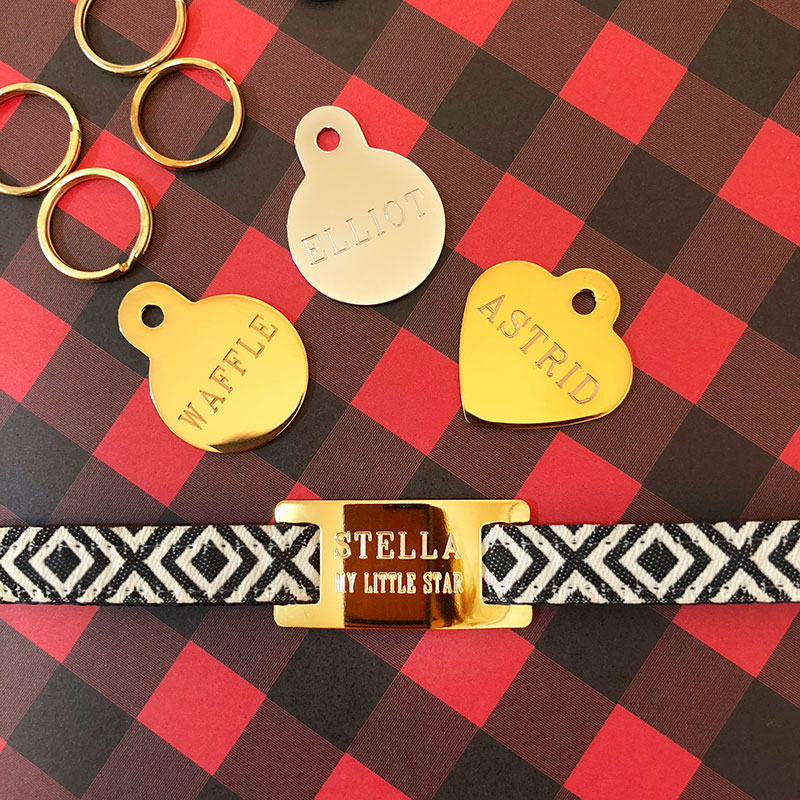Your Cart is Empty
Tips For Customizing Pet ID Tags
by Alex Harmon
Tips For What to Include on Pet ID Tags:
Do's & Don'ts
Here at Made By Cleo, we engrave a lot of pet ID tags each day. As a result, we’ve learned just as much about what NOT to include on a custom pet ID tag, as we have about what SHOULD be included. Ultimately, there’s a balance to achieve between putting the right amount of information on an ID tag, and making sure you don’t end up with so much text that the overall legibility suffers. Here are the top considerations to keep in mind when deciding on what to put on your pet's ID tag:
Size Matters
Made By Cleo offers collars specifically sized for cats and small dogs. As such, our pet ID tag sizes are naturally a little smaller than your average pet tags -- to maintain proportion with the collars. In terms of scale, our circle tags are roughly the size of an American nickel coin (.835 inches/21.21 mm), our heart-shaped tags are slightly wider than an American quarter at the top and taper toward the bottom, and our slide tags are slightly less tall than an American dime. Additionally, our engraving machines will automatically decrease the font size of the text to make it all fit, the more text there is overall. As such, trying to squeeze an equivalent of a novel on your pet’s new ID tag will result in a trade-off on legibility. Bottom line — when you're working with a smaller canvas, every extra letter you include affects the visibility & legibility of the text. Keep the content minimal.

Prioritize Your Info — Not All Details Are Equally Important
- 1. Your phone number is the most important piece of information. If there is one thing that absolutely needs to be on your pet's ID tag, it is your phone number. Your pet’s name is even secondary in the event that he/she is lost and someone finds them.
- 2. Your street address can be helpful to include, but optional. Having your address on an ID tag is nice in the event that someone a few houses down or someone familiar with the neighborhood finds your pet. Still, this information is optional, since you can give them your address as soon as they call or text you (see above).
- 3. City, State & ZIP are usually unnecessary on a pet ID tag. The odds of your pet ending up in another city/state is pretty small. If you do include your address on an ID tag, keep in mind that it’s unlikely your pet will end up in another city. As such, including your city, state, and zip usually just takes up a large amount of space and compromises the legibility of the most important part (i.e. the phone #). In the unlikely event that your pet does go on a big adventure, surely whoever finds them will have a phone handy and will call you (again, see #1) well before they even think about mailing your pet back to you! ;-)
- 4. Don’t bother including your email address (unless your phone # is not a reliable way to contact you).It may be tempting to try and include multiple ways to contact you, via your pet's ID tag. Not only do we understand that - we encourage it - but only when done sensibly. Including an email address is not the way. Unless your address is really short - like bob@bob.com, odds are it’s going to be too long to fit on a line easily and therefore it will just take up important space. Also, email is a less immediate way to communicate with a person than calling or texting them on a phone. Some people don't even check their email for days...If you want to include additional ways to contact you, consider including an alternate phone number (of perhaps a spouse or family member)?
- 5. Microchip information takes up a lot of space.It’s helpful to know that a pet is microchipped, in case he or she is found by someone who knows what to do with that information. The general idea is that whoever finds the pet can look up a microchip number in a database online, assuming they know the resource is available. However, including a microchip # on the pet's ID tag usually requires taking up several lines of text (since the numbers are very long). Also, not everyone who may end up finding your pet will know what to do with that long, weird-looking number. It's simply not as self-explanatory and intuitive as, say, a phone number. If you want to include microchip details *just in case* (which CAN be handy if your phone # or address changes before you've had time to update the info on the pet tag — consider including a simple mention of “Microchipped” or "Microchip" on the tag. This will alert the finder to take the pet somewhere, where the microchip can be made useful (like a vet or animal shelter, who would have the ability to scan the pet). And finally, keep in mind that the most important info that would be revealed by scanning the microchip should already be included on the ID tag anyway.
Use Both Sides to Your Benefit
Our circle and heart-shaped traditional "hanging" tags have both an engraveable front and back, and we strongly encourage you to take advantage of both. If you need to include a few extra pieces of information on your tag, try splitting up the information between the front and the back. For example, you might include the name of your pet and your phone number on the front of the tag, and your address on the back. Note: We recommend avoiding trying to cram all the information on the same side (unless it's just a name & phone # on each side). It ends up making all of the text unnecessarily small. Consider sensibly splitting the info across front & back for best results in terms of legibility and overall attractive appearance.
Medication and Health Concerns
One of the benefits of having a pet wear an ID tag is that you can use the tag to alert the finder that your pet requires medication or has special needs. A lost pet may be missing for several days and in need of his/her medication to stay healthy / alive. A notice that your pet requires medication can imply a sense of urgency to whomever might find your pet -- and they may be more likely to act quickly to get in contact with you. A common phrasing we see on pet tags is “Needs meds” or “RX needed” – both are short and effective. Likewise, if your pet is blind, deaf, or impaired in any other way, it’s beneficial to include this detail on your ID tag.

Hopefully the suggestions above provide some helpful guidance on the most essential things to include on your pet ID tags. After all, space is limited and we recognize that it may be difficult to pare down your ID tag text to just the critical details. When in doubt, try using the ID tag personalizer tool here to test out different formatting choices you may want to consider. It's especially helpful for visualizing how to break up the information you plan to have engraved on the tag. Made By Cleo has a large selection of elegant but practical ID tag styles and colors starting at $7.95 available here.
Subscribe to our BLOG & NEWSLETTER
Sign up for our email newsletter so you don't miss our next blog post, sale or new product announcements!

